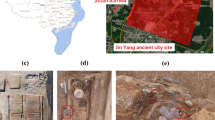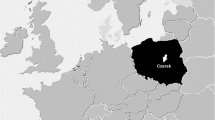Abstract
It is identified for the first time that, during process of complicated deformation in eolian conditions - mechanical transformation of flaky gold into toroidal form and then into globular-hollow form, gold is cleaned up to absolutely pure metal with fineness 1000‰. Note that, fineness of this eolian gold is higher than fineness of the reference object, shown by the detecting device (JXA-5OA micro-analyzer). In this connection, identified natural process of gold cleaning in eolian conditions can be successfully used in gold metallurgy to obtain absolutely pure gold.
You have full access to this open access chapter, Download conference paper PDF
Similar content being viewed by others
Keywords
1 Introduction
Native gold in exogenetic conditions, depending on its environment, undergoes gradual changes, in morphology and material composition. It is known that, gold cleaning in exogenetic conditions occurs mainly under chemical and physical-chemical influence in weathering crusts, and also as a result of simple strain in geodynamic conditions. This report will be focused on gold cleaning as a result of impact of mechanogenic processes in eolian conditions.
2 Methods and Approaches
Chemical composition of eolian gold of the Lena-Viluy interfluve (east Siberian platform) was studied by atomic-absorption spectrography (30 objects), spectral quantitative analysis (50 objects), and at JXA-5OA micro-analyzer (30 objects and 200 identifications).
3 Results and Discussion
During mechanical impact of sand grains on gold in eolian conditions, not only the form is transformed, but also inner structure and chemical composition are regularly changed. It is identified that, process of gold cleaning is more intensive in eolian conditions, than in hydrodynamic conditions (Nikiforova 1999).
According to the analysis of eolian gold by atomic-absorption method, increase of gold fineness during transformation of flaky forms into globular-hollow forms from 810 to 970‰ is identified. Flaky gold with scarcely noticeable elevation at the periphery, has fineness range 810–970‰, with average gold fineness 890‰. In toroidal gold, interval of gold fineness fluctuation is identified - 920–970‰, with average index 940‰. Globular-hollow form is characterized by high gold fineness - 960–990‰, with average fineness 970‰.
Spectral quantitative analysis identified that, constant trace elements of flaky forms with characteristic features of eolian transformation are Fe- 0,1; Pb- 0,003; Sb- 0,002 Cu-0,017; Mn- 0,01; Pd- 0,002.; Ni-traces; Hg- traces. And some other. In toroidal gold, a smaller set of trace elements is identified Fe- 0,1; Cu-0,02; Mn- 0,03; Ni- traces; Hg- traces, and in globular-hollow body only these trace elements are identified – Fe- 0,1; Cu-0,05; Mn- 0,001.
Study of fineness of different areas of gold particles (Table 1 and Fig. 1) allowed identifying that, a flake with medium-grained structure (grain C-9a) has fineness from 747 t0 780‰, and its more high-standard shell – from 950 to 988‰. Flake P-138 with partially recrystallized rim has gold fineness 900–970‰, and its central part 814–860‰. Fully recrystallized flake showed maximum gold fineness – 990–1000‰. Fineness of globular-hollow gold within one sample is not just high, but has an absolute value - 1000‰. For example, 17 identifications in the grain 60a found insignificant fluctuations of fineness within interval 992–1000‰, and 13 identifications in the grain 60b showed the highest gold fineness – 1000‰.
It should be emphasized that, shell of globular-hollow forms constantly shows absolutely high fineness 1000‰. Just in several samples, primary gold preserved in partition, is characterized by lower fineness within a range from 860 to 919‰, for example grain 19b.
Increase of gold fineness in eolian conditions is explained by the fact that, as a result of complex deformation of flaky gold, very thin films of gold (fraction of mcm) are formed, being overlapped on each other, generate a shell of globular forms. In addition, surface for active chemical interaction of metal with environmental elements is increased, that contributed to the maximum removal of silver and trace elements from primary gold particles.
It should be emphasized that, shell of globular-hollow forms constantly shows absolutely high fineness 1000‰. Just in several samples, primary gold preserved in partition, is characterized by lower fineness within a range from 860 to 919‰, for example grain 19b.
Increase of gold fineness in eolian conditions is explained by the fact that, as a result of complex deformation of flaky gold, very thin films of gold (fraction of mcm) are formed, being overlapped on each other, generate a shell of globular forms. In addition, surface for active chemical interaction of metal with environmental elements is increased, that contributed to the maximum removal of silver and trace elements from primary gold particles.
The process of mechanically gold cleaning was proved by (Lechtman 1979) experimentally. According to the results of his experiments, clean layer of gold appeared after multiple alteration of forging of gold and copper alloy, with its processing in weak ammonia solution, where initial gold content did not exceed 12%.
4 Conclusions
It is identified for the first time, that during complex deformation, when flaky gold is mechanically transformed into toroidal form and then into globular-hollow form, metal is cleaned to absolutely pure gold with fineness 1000‰. Identified natural process of gold cleaning in eolian conditionsв can be successfully used in gold metallurgy to obtain absolutely pure gold.
References
Lechtman H (1979) A pre-Columbian technique for electrochemical replacement plating of gold and silver on copper objects. J Metals 31(12):154–160
Nikiforova ZS (1999) Typomorphic features of eolian gold. ZVMO. N5, pp 79–83
Acknowledgements
The work is implemented within scientific-research projects of Diamond and Precious Metal Geology Institute, Russian Academy of Sciences, project № 0381-2016-0004.
Author information
Authors and Affiliations
Corresponding author
Editor information
Editors and Affiliations
Rights and permissions
Open Access This chapter is licensed under the terms of the Creative Commons Attribution 4.0 International License (http://creativecommons.org/licenses/by/4.0/), which permits use, sharing, adaptation, distribution and reproduction in any medium or format, as long as you give appropriate credit to the original author(s) and the source, provide a link to the Creative Commons license and indicate if changes were made.
The images or other third party material in this chapter are included in the chapter's Creative Commons license, unless indicated otherwise in a credit line to the material. If material is not included in the chapter's Creative Commons license and your intended use is not permitted by statutory regulation or exceeds the permitted use, you will need to obtain permission directly from the copyright holder.
Copyright information
© 2019 The Author(s)
About this paper
Cite this paper
Nikiforova, Z. (2019). Absolutely Pure Gold with High Fineness 1000‰. In: Glagolev, S. (eds) 14th International Congress for Applied Mineralogy (ICAM2019). ICAM 2019. Springer Proceedings in Earth and Environmental Sciences. Springer, Cham. https://doi.org/10.1007/978-3-030-22974-0_25
Download citation
DOI: https://doi.org/10.1007/978-3-030-22974-0_25
Published:
Publisher Name: Springer, Cham
Print ISBN: 978-3-030-22973-3
Online ISBN: 978-3-030-22974-0
eBook Packages: Earth and Environmental ScienceEarth and Environmental Science (R0)





